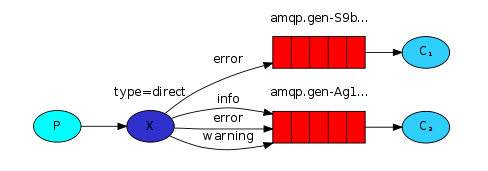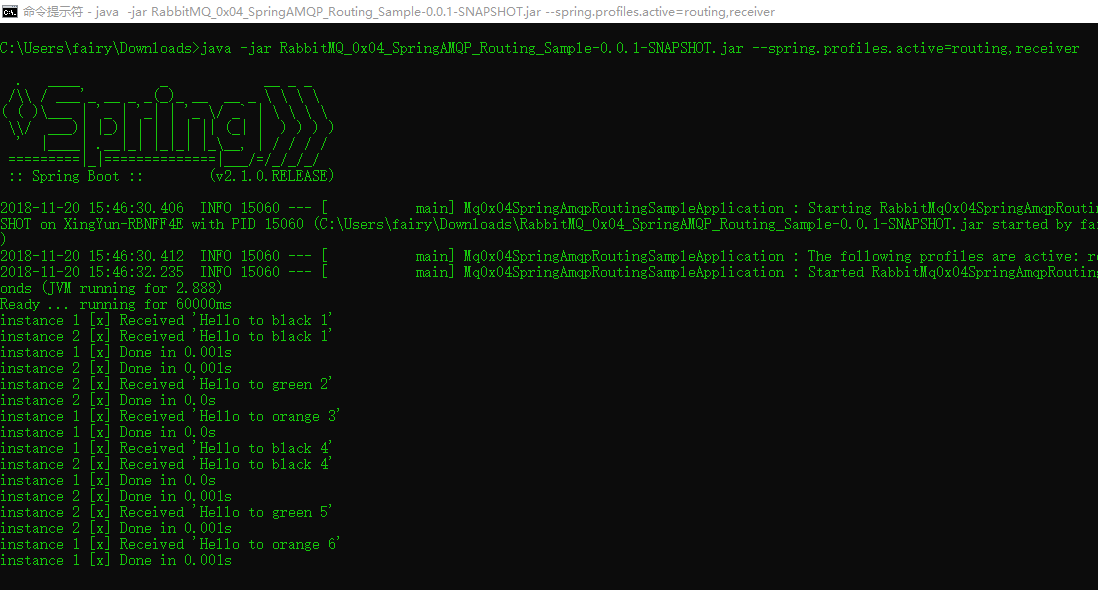在上一个教程中,我们构建了一个简单的fanout(扇出)交换。我们能够向许多接收者广播消息。
在本教程中,我们将为其添加一个功能 - 我们将只能订阅一部分消息。例如,我们将只能将消息指向感兴趣的特定颜色(“orange”,“black”,“green”),同时仍然能够在控制台上打印所有消息。
绑定
在前面的例子中,我们已经在创建绑定。您可以在我们的Tut3Config文件中调用这样的代码:
@Bean public Binding binding1(FanoutExchange fanout, Queue autoDeleteQueue1) { return BindingBuilder.bind(autoDeleteQueue1).to(fanout); }
绑定是交换和队列之间的关系。这可以简单地理解为:队列对来自此交换的消息感兴趣。
绑定可以采用额外的routingKey参数。Spring-amqp使用流畅的API来使这种关系非常清晰。我们将交换和队列传递到BindingBuilder,并简单地将队列绑定到交换机“与路由密钥”,如下所示:
@Bean public Binding binding1a(DirectExchange direct, Queue autoDeleteQueue1) { return BindingBuilder.bind(autoDeleteQueue1) .to(direct) .with("orange"); }
绑定密钥的含义取决于交换类型。我们之前使用的 fanout 交换只是忽略了它的价值
Direct exchange 直接交换
我们上一个教程中的消息系统向所有消费者广播所有消息。我们希望扩展它以允许根据颜色类型过滤消息。例如,我们可能需要一个程序将日志消息写入磁盘以仅接收严重错误,而不是在警告或信息日志消息上浪费磁盘空间。
我们使用的是fanout exchange(扇出交换),它没有给我们太大的灵活性 - 它只能进行无意识的广播。
我们将使用direct exchange (直接交换)。direct change (直接交换) 背后的路由算法很简单 - 消息进入队列,其 绑定密钥与消息的路由密钥完全匹配。
为了说明这一点,请考虑以下设置:

在此设置中,我们可以看到direct exchange(直接交换) X与两个绑定到它的队列。第一个队列绑定orange绑定,第二个绑定有两个绑定,一个绑定密钥为黑色,另一个绑定为绿色。
在这样的设置中,使用路由密钥orange发布到exchange的消息 将被路由到队列Q1。路由键为black 或green 的消息将转到Q2。所有其他消息将被丢弃。
多个绑定

使用相同的绑定密钥绑定多个队列是完全合法的。在我们的例子中,我们可以在X和Q1之间添加绑定键black的绑定。
在这种情况下,direct exchange(直接交换)将表现得像fanout (扇出)一样,并将消息广播到所有匹配的队列。路由密钥为black的消息将传送到 Q1和Q2。
发布消息
我们将此模型用于我们的路由系统。我们会将消息发送给direct change (直接交换),而不是fanout(扇出)。
我们将提供颜色作为路由键。这样接收程序将能够选择它想要接收(或订阅)的颜色。让我们首先关注发送消息。
与往常一样,我们在Tut4Config中进行一些Spring Boot 配置:
@Bean public FanoutExchange fanout() { return new FanoutExchange("tut.fanout"); }
我们已经准备好发送消息了。颜色,如图中所示,可以是“orange”,“black”或“green”之一。
订阅
接收消息将像上一个教程一样工作,但有一个例外 - 我们将为我们感兴趣的每种颜色创建一个新的绑定。这也适用于Tut4Config
@Bean public DirectExchange direct() { return new DirectExchange("tut.direct"); } ... @Bean public Binding binding1a(DirectExchange direct, Queue autoDeleteQueue1) { return BindingBuilder.bind(autoDeleteQueue1) .to(direct) .with("orange"); }
放到一起

配置类
Tut4Config.java
import org.springframework.amqp.core.*; import org.springframework.context.annotation.Bean; import org.springframework.context.annotation.Configuration; import org.springframework.context.annotation.Profile; import com.xingyun.springamqp.business.Tut4Receiver; import com.xingyun.springamqp.business.Tut4Sender; @Profile({"tut4","routing"}) @Configuration public class Tut4Config { @Bean public DirectExchange direct() { return new DirectExchange("tut.direct"); } @Profile("receiver") private static class ReceiverConfig { @Bean public Queue autoDeleteQueue1() { return new AnonymousQueue(); } @Bean public Queue autoDeleteQueue2() { return new AnonymousQueue(); } @Bean public Binding binding1a(DirectExchange direct, Queue autoDeleteQueue1) { return BindingBuilder.bind(autoDeleteQueue1) .to(direct) .with("orange"); } @Bean public Binding binding1b(DirectExchange direct, Queue autoDeleteQueue1) { return BindingBuilder.bind(autoDeleteQueue1) .to(direct) .with("black"); } @Bean public Binding binding2a(DirectExchange direct, Queue autoDeleteQueue2) { return BindingBuilder.bind(autoDeleteQueue2) .to(direct) .with("green"); } @Bean public Binding binding2b(DirectExchange direct, Queue autoDeleteQueue2) { return BindingBuilder.bind(autoDeleteQueue2) .to(direct) .with("black"); } @Bean public Tut4Receiver receiver() { return new Tut4Receiver(); } } @Profile("sender") @Bean public Tut4Sender sender() { return new Tut4Sender(); } }
生产者
Tut4Sender.java
import org.springframework.amqp.core.DirectExchange; import org.springframework.amqp.rabbit.core.RabbitTemplate; import org.springframework.beans.factory.annotation.Autowired; import org.springframework.scheduling.annotation.Scheduled; public class Tut4Sender { @Autowired private RabbitTemplate template; @Autowired private DirectExchange direct; private int index; private int count; private final String[] keys = {"orange", "black", "green"}; @Scheduled(fixedDelay = 1000, initialDelay = 500) public void send() { StringBuilder builder = new StringBuilder("Hello to "); if (++this.index == 3) { this.index = 0; } String key = keys[this.index]; builder.append(key).append(' '); builder.append(Integer.toString(++this.count)); String message = builder.toString(); template.convertAndSend(direct.getName(), key, message); System.out.println(" [x] Sent '" + message + "'"); } }
消费者
Tut4Receiver.java
import org.springframework.amqp.rabbit.annotation.RabbitListener; import org.springframework.util.StopWatch; public class Tut4Receiver { @RabbitListener(queues = "#{autoDeleteQueue1.name}") public void receive1(String in) throws InterruptedException { receive(in, 1); } @RabbitListener(queues = "#{autoDeleteQueue2.name}") public void receive2(String in) throws InterruptedException { receive(in, 2); } public void receive(String in, int receiver) throws InterruptedException { StopWatch watch = new StopWatch(); watch.start(); System.out.println("instance " + receiver + " [x] Received '" + in + "'"); doWork(in); watch.stop(); System.out.println("instance " + receiver + " [x] Done in " + watch.getTotalTimeSeconds() + "s"); } private void doWork(String in) throws InterruptedException { for (char ch : in.toCharArray()) { if (ch == '.') { Thread.sleep(1000); } } } }
查看用法
java -jar RabbitMQ_0x04_SpringAMQP_Routing_Sample-0.0.1-SNAPSHOT.jar

启动生产者
java -jar RabbitMQ_0x04_SpringAMQP_Routing_Sample-0.0.1-SNAPSHOT.jar --spring.profiles.active=routing,sender

启动消费者
java -jar RabbitMQ_0x04_SpringAMQP_Routing_Sample-0.0.1-SNAPSHOT.jar --spring.profiles.active=routing,receiver
